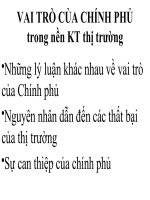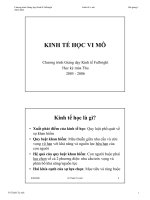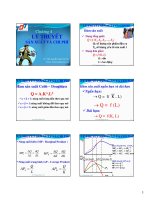- Trang chủ >>
- Đại cương >>
- Kinh tế vĩ mô
BÀI GIẢNG KINH TẾ VĨ MÔ (MACROECONOMICS I)
Bạn đang xem bản rút gọn của tài liệu. Xem và tải ngay bản đầy đủ của tài liệu tại đây (7.05 MB, 205 trang )
FOREIGN TRADE UNIVERSITY
Department of Macroeconomics
MACROECONOMICS
I
Assoc. Prof., PhD Hoang Xuan Binh
A PowerPointTutorial
to Accompany macroeconomics, 5th ed.
N. Gregory Mankiw
CHAPTER I:
Introduction Lecture programme
Introduction
Module title: Macroeconomics I
Semester: I
Year 2015-2016
Level: Undergraduate
Module Convenor: Hoang Xuan Binh
Office hours: 15 -17 on Monday
Tel: 844-32595158 ext 228
Cellphone: 0912782608
Email:
INTRODUCTION
Module Context:
The module is designed especially for
students taking Macroeconomics at FTU. It
is intended to provide students with an
understanding of important macroeconomic
factors and variables. The course analyses
how macroeconomic variables operate;and it
develops an understandings of the
international money and financial market, in
or outflows of capital. The course also draws
on the debates in real economy and tries to
use both old and new theories to understand
them.
Introduction
Module aims and objectives:
1.To familiarise the students with some of the most
important macroeconomic variables in the
economy, for example GDP,GNP,CPI,PPI…
2.To introduce students to some important
macroeconomic policies including fiscal and
monetary policies.
3.To examine some different cases in term of using
macroeconomic policies to develop economy.
Introduction
Learning outcomes
By the end of this module it is expected that students:
1.will have an understanding of how important
macroeconomic variables are interacting in the
economy.
2.will be able to interpret such variables and events as
GDP,GNP,CPI or inflation,unemployment… and relate
them to changes of other variables and events in the
economy.
3.will be ready to explain significant events in real
economy by using economic theories.
4.will be familiar with current debates on openeconomy and able to make a critical assessment of the
various arguments which are put forward.
Teaching and learning methods:
In class contact hours there will be
lectures,
discussions and assistance with students’assignment
work,reading and using books. During the seminars the
students will be expected to discuss the provided topics
on the problems of real economy.
Assessment methods:
There is a written assignment and final examination.
It is worthy 30% and 60% respectively. Class
participation is 10% .
Suggested Supplementary Reading
Mankiw, Principles of Economics
Mankiw, Macroeconomics 5th ed ,
Sloman J., (2003), Economics, 5th ed
Lecture programme
Chapter: Introduction lecture programme
Chapter2:The Data of Macroeconomics
Chapter3:Aggregate Demand and Fiscal policy
Chapter4:Money and Monetary policy
Chapter5:Inflation and unemployment
Presentation assignment
Chapter6:Economic growth
Chapter 7: The Open economy
Revision
I.Introduction
Everyone is concerned about macroeconomics
lately. We wonder why some countries are growing faster
than others and why inflation fluctuates. Why?
Because the state of the macroeconomy affects
everyone in many ways. It plays a significant
role in the political sphere while also affecting
public policy and social well-being.
There is much discussion of recessions-- periods in which real
GDP falls mildly-- and depressions, concerns with issues such as
inflation, unemployment, monetary and fiscal policies.
Economists use models to understand what goes on in the economy.
Here are two important points about models: endogenous variables
and exogenous variables. Endogenous variables are those which the
model tries to explain. Exogenous variables are those variables that
a
model takes as given. In short, endogenous are variables within a
model, and exogenous are the variables outside the model.
Price
Supply
P*
Q*
This is the most famous
economic model. It describes
the ubiquitous relationship
Demand between buyers and sellers in
the market. The point of
Quantity
intersection is called an
equilibrium.
Economists typically assume that the market will go into
an equilibrium of supply and demand, which is called
the market clearing process. This assumption is central
to the Pho example on the previous slide. But, assuming
that markets clear continuously is not realistic. For
markets to clear continuously, prices would have to
adjust instantly to changes in supply and demand. But,
evidence suggests that prices and wages often adjust
slowly.
So, remember that although market clearing models
assume that wages and prices are flexible, in actuality,
some wages and prices are sticky.
Microeconomics is the study of how households and firms
make decisions and how these decision makers interact in the
marketplace. In microeconomics, a person chooses to
maximize his or her utility subject to his or her budget constraint.
Macroeconomic events arise from the interaction of many
people trying to maximize their own welfare. Therefore, when
we study macroeconomics, we must consider its
microeconomic foundations.
II. Research aims and research methods:
1. Aims and objectives of macroeconomics
Yield, Economic growth, unemployment,
inflation, budget, Balance of Payments,
2. Research method
- Mathematics, general equilibrium, Walras
methods (equilibrium in all market…
III. Macroeconomics system
1. Inputs
+ Exogenous variables: weather, politics,
population, technology and patents or
know-how
+Endogenous variables: direct impactsfiscal policy,monetary policy, external
economic policy
2. Black box: AS+AD
2.1. Aggregate Demand
*Related factors: Price, Income, Expectation…
2.2.Aggregate Supply
* Related factors: Price,production cost,
potential output (Y*)
Y*: maximization of output which economy
can produce, with full-employment and no
inflation.
Full-employment=population–outof
working age - invalids -(pupils + students) –
servant-unwilling to work
3. Outputs
Yield, employment,
Average price,
Inflation,interest,budget,
Trade balance and balance of
International payment,
Economic Growth
Macroeconomics
Macroeconomics
Recession
Recession
Depression
Depression
Models
Models
Macroeconomic
Macroeconomicsystem
system
Inputs
Inputs
Outputs
Outputs
Endogenous
Endogenousvariables
variables
Exogenous
Exogenousvariables
variables
Market
Marketclearing
clearing
Flexible
Flexibleand
andsticky
stickyprices
prices
Microeconomics
Microeconomics
CHAPTER II
Data of macroeconomics
I. Gross domestic products-GDP
Gross Domestic Product (GDP) is the
market value of all final goods and
services produced within an economy
in a given period of time.
Income, Expenditure
And the Circular Flow
There are 2 ways
of viewing GDP
Total income of everyone in the economy
Total expenditure on the economy’s
output of goods and services
Income $
Labor
Households
Firms
Goods
Expenditure $
For the economy as a whole, income must equal expenditure.
GDP measures the flow of dollars in this economy.
II.Computing GDP
1.Rules for computing GDP
1) To compute the total value of different goods and services,
the national income accounts use market prices.
Thus, if
$0.50
$1.00
GDP = (Price of apples × Quantity of apples)
+ (Price of oranges × Quantity of oranges)
= ($0.50 × 4) + ($1.00 × 3)
GDP = $5.00
2) Used goods are not included in the calculation of GDP.
3) The treatment of inventories depends on
if the goods are stored or if they spoil. If
the goods are stored, their value is
included in GDP.
If they spoil, GDP remains unchanged.
When the goods are finally sold out of
inventory, they are considered used goods
(and are not counted).
4) Intermediate goods are not counted in
GDP… only the value of final goods. Reason:
the value of intermediate goods is already
included in the market price.
Value added of a firm equals the value of the
firm…s output less the value of the
intermediate goods the firm purchases.
5) Some goods are not sold in the marketplace
and therefore don’t have market prices. We must
use their imputed value as an estimate of their
value. For example, home ownership and
government services.
The value of final goods and services measured at
current prices is called nominal GDP. It can change
over time either because there is a change in the
amount (real value) of goods and services or a change in
the prices of those goods and services.
Hence, nominal GDP Y = P × y, where P is the price
level and y is real output– and remember we use output
and GDP interchangeably.
Real GDP or, y = Y÷P is the value of goods and services
measured using a constant set of prices.
Let’s see how real GDP is computed in our apple and
orange economy.
For example, if we wanted to compare output in 2002 and
output in 2003, we would obtain base-year prices, such as 2002
prices.
Real GDP in 2002 would be:
(2002 Price of Apples × 2002 Quantity of Apples) +
(2002 Price of Oranges × 2002 Quantity of Oranges).
Real GDP in 2003 would be:
(2002 Price of Apples × 2003 Quantity of Apples) +
(2002 Price of Oranges × 2003 Quantity of Oranges).
Real GDP in 2004 would be:
(2002 Price of Apples × 2004 Quantity of Apples) +
(2002 Price of Oranges × 2004 Quantity of Oranges).









